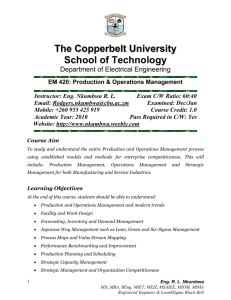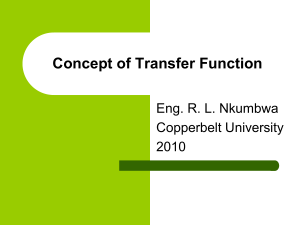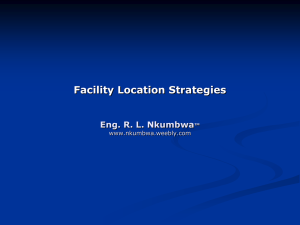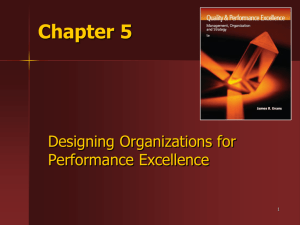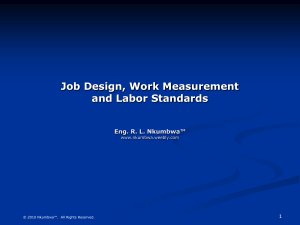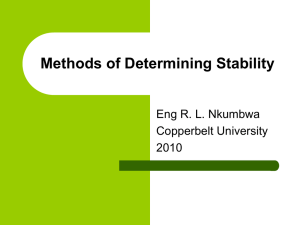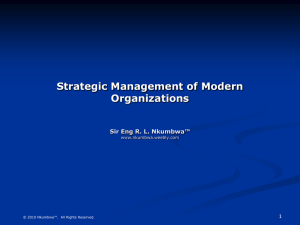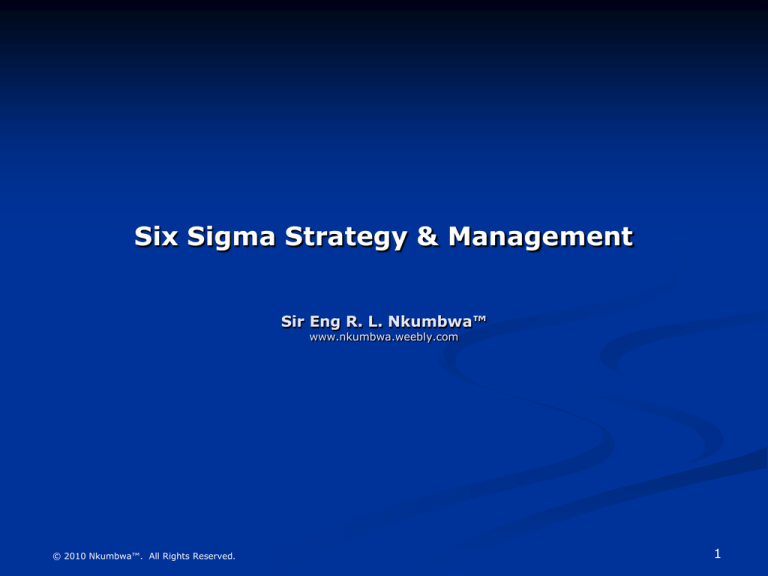
Six Sigma Strategy & Management
Sir Eng R. L. Nkumbwa™
www.nkumbwa.weebly.com
© 2010 Nkumbwa™. All Rights Reserved.
1
Outline
What is Six Sigma?
Phases of Six Sigma
Define
Measure
Evaluate / Analyze
Improve
Control
Design for Six Sigma
Green Belts & Black Belts
© 2010 Nkumbwa™. All Rights Reserved.
2
What is Six Sigma?
A Vision and Philosophical commitment to our
consumers to offer the highest quality, lowest cost
products
A Metric that demonstrates quality levels at
99.9997% performance for products and processs
A Benchmark of our product and process capability
for comparison to ‘best in class’
A practical application of statistical Tools and Methods
to help us measure, analyze, improve, and control our
process
© 2010 Nkumbwa™. All Rights Reserved.
3
What Six Sigma is Not
Just about statistics
A quality program
Only for technical people
Used when the solution is known
Used for “firefighting”
© 2010 Nkumbwa™. All Rights Reserved.
4
Why Companies Need Six Sigma
1.
Reduces dependency on “Tribal Knowledge”
- Decisions based on facts and data rather than opinion
2.
Attacks the high-hanging fruit (the hard stuff)
- Eliminates chronic problems (common cause variation)
- Improves customer satisfaction
3.
Provides a disciplined approach to problem solving
- Changes the company culture
4.
Creates a competitive advantage (or disadvantage)
5.
Improves profits!
© 2010 Nkumbwa™. All Rights Reserved.
5
How good is good enough?
99.9% is already VERY GOOD
But what could happen at a quality level of 99.9% (i.e., 1000 ppm),
in our everyday lives (about 4.6)?
•
4000 wrong medical prescriptions each year
•
More than 3000 newborns accidentally falling
from the hands of nurses or doctors each year
•
Two long or short landings at American airports each day
•
400 letters per hour which never arrive at their destination
© 2010 Nkumbwa™. All Rights Reserved.
6
How can we get these results?
13 wrong drug prescriptions per year
10 newborn babies dropped by doctors/nurses per year
Two short or long landings per year in all the airports in the U.S.
One lost article of mail per hour
© 2010 Nkumbwa™. All Rights Reserved.
7
Six Sigma as a Metric
Sigma = = Deviation
( Square root of variance )
7
6
5
4
3
2
1
0
-1
-2
-3
-4
-5
-6
-7
Axis graduated in Sigma
between + / - 1
68.27 %
between + / - 2
95.45 %
45500 ppm
between + / - 3
99.73 %
2700 ppm
between + / - 4
99.9937 %
63 ppm
between + / - 5
99.999943 %
0.57 ppm
between + / - 6
99.9999998 %
0.002 ppm
© 2010 Nkumbwa™. All Rights Reserved.
result: 317300 ppm outside
(deviation)
8
Effect of 1.5 Sigma Process Shift
© 2010 Nkumbwa™. All Rights Reserved.
9
3 Sigma Vs. 6 Sigma
The 3 sigma Company
Spends 15~25% of sales dollars on cost of
failure
Relies on inspection to find defects
Does not have a disciplined approach to
gather and analyze data
Benchmarks themselves against their
competition
The 6 sigma Company
Relies on capable process that don’t produce
defects
Use Measure, Analyze, Improve, Control and
Measure, Analyze, Design
Benchmarks themselves against the best in
the world
Believes 99% is good enough
Define CTQs internally
© 2010 Nkumbwa™. All Rights Reserved.
Spends 5% of sales dollars on cost of failure
Believes 99% is unacceptable
Defines CTQs externally
10
Sigma and PPM
PPM
2
308,537
80
800000
70
66,811
6,210
4
60
% Change
3
700000
From 5 to 6
600000
50
500000
PPM
% Change
40
400000
From 4 to 5
30
300000
20
233
5
200000
From 3 to 4
10
100000
From 1 to 2
0
3.4
6
Process
Capability
PPM
0
1
2
3
4
5
6
Process Sigma
Defects per Million
Opportunities
Focusing on requires thorough process
understanding and breakthrough thinking
© 2010 Nkumbwa™. All Rights Reserved.
11
Six Sigma ROI
Motorola ROI
1987-1994
• Reduced in-process defect levels by a factor of 200.
• Reduced manufacturing costs by $1.4 billion.
• Increased employee production on a dollar basis by 126%.
• Increased stockholders share value fourfold.
AlliedSignal ROI
1992-1996
• $1.4 Billion cost reduction.
• 14% growth per quarter.
• 520% price/share growth.
• Reduced new product introduction time by 16%.
• 24% bill/cycle reduction.
© 2010 Nkumbwa™. All Rights Reserved.
12
Six Sigma ROI
General Electric ROI
1995-1998
• Company wide savings of over $1 Billion.
• Estimated annual savings to be $6.6 Billion by the year 2000.
© 2010 Nkumbwa™. All Rights Reserved.
13
Costs
Six Sigma as a Philosophy
Internal &
External
Failure
Costs
is a measure of how much
variation exists in a process
Prevention &
Appraisal
Costs
Old Belief
Old Belief
4
High Quality = High Cost
Quality
New Belief
High Quality = Low Cost
Costs
Internal &
External
Failure Costs
Prevention &
Appraisal
Costs
4
New Belief
5
6
Quality
© 2010 Nkumbwa™. All Rights Reserved.
14
“The fact is, there is more reality with this
[Six Sigma] than anything that has come
down in a long time in business. The more
you get involved with it, the more you’re
convinced.”
Larry Bossidy
CEO, Honeywell
© 2010 Nkumbwa™. All Rights Reserved.
15
Six Sigma as a Strategic Tool
Issue
Classical
Six Sigma
Outlook
Short term
Long term
Analysis
Point estimate
Variability
Tolerance
Worst case design
RMS
Process
Tweaking
SPC
Problem
Fixing
Preventing
Behavior
Reactive
Proactive
Reasoning
Experience
Statistics
Aim
Organization
Customer
Direction
Seat of Pants
Benchmarking
Improvement
Automation
Optimization
© 2010 Nkumbwa™. All Rights Reserved.
16
Six Sigma Tools
Process Mapping
Tolerance Analysis
Structure Tree
Components Search
Pareto Analysis
Hypothesis Testing
Gauge R & R
Regression
Rational Subgrouping
DOE
Baselining
SPC
© 2010 Nkumbwa™. All Rights Reserved.
17
What Does Six Sigma Look Like?
Project defined in Business Terms
Cross Functional Team Involvement
DMAIC Problem Strategy used
Qualitative and Statistical tools used
Sustained Business Results Achieved
© 2010 Nkumbwa™. All Rights Reserved.
18
Six Sigma Principles
Customer Focus
Leadership
Innovative and Proactive
Boundary-less
World Class Quality
Fact Driven
Process Management
© 2010 Nkumbwa™. All Rights Reserved.
19
Problem Solving Methodology
Phase 1:
Define
Characterization
Phase 2:
Measure
Phase 3:
Breakthrough
Strategy
Analyze
Phase 4:
Improve
Optimization
Phase 5:
Control
Projects are worked through these 5 main
phases of the Six Sigma methodology.
© 2010 Nkumbwa™. All Rights Reserved.
20
Project Charter
Business Case
Problem Statement
Goal Statement
Team Members
Team Role & Responsibility
Action plan VS. budget
© 2010 Nkumbwa™. All Rights Reserved.
21
Define Phase
Define Process
Define Customer requirement
Prioritize Customer requirement
© 2010 Nkumbwa™. All Rights Reserved.
22
Define Phase
SIPOC Model
Kano Analysis
Customer Survey CTQ Diagram
Customer Requirement Analysis
QFD
Literature Review
Standard / Regulation Review
© 2010 Nkumbwa™. All Rights Reserved.
23
Define Phase
Project Review
Project Charter
Business Case
Problem Statement
Goal Statement
Scope of process
Prioritized customer requirement
© 2010 Nkumbwa™. All Rights Reserved.
24
Problem Definition
What do you want to improve?
What is your ‘Y’?
Reduce
Complaints
(int./ext.)
Reduce
Defects
Reduce
Cost
What are the Goals?
Problem Definitions need to be based on
quantitative facts supported by analytical data.
© 2010 Nkumbwa™. All Rights Reserved.
25
Map the Process
Identify the variables - ‘x’
Measure the Process
Understand the Problem ’Y’ = function of variables -’x’
Y=f(x)
To understand where you want to be,
you need to know how to get there.v
© 2010 Nkumbwa™. All Rights Reserved.
26
Measure
Characterize Process
Evaluate
Control
Understand Process
Maintain New Process
Improve
Improve and Verify Process
© 2010 Nkumbwa™. All Rights Reserved.
27
Measure Phase
Understand
Process
Define
Problem
Defect
Statement
Project
Goals
Define Process-
Process Mapping
Historical
Performance
Brainstorm
Potential Defect
Causes
© 2010 Nkumbwa™. All Rights Reserved.
Collect
Data
Process
Performance
Data Types
Process Capability
- Defectives
- Cp/Cpk
- Defects
- Run Charts
- Continuous
Understand Problem
Measurement
(Control or
Systems Evaluation
Capability)
(MSE)
28
Measure Phase
Identify measurement and variation
Determine data type
Develop data collection plan
Perform measurement system analysis
Perform data collection
Perform capability analysis
© 2010 Nkumbwa™. All Rights Reserved.
29
Measure Phase
Effectiveness of existing process
Efficiency of existing process
Calculate Sigma Level
Calculate Cost of poor quality
© 2010 Nkumbwa™. All Rights Reserved.
30
Measure Phase
SIPOC-RM
CTQ-R
Check Sheet
MSA
Basic Statistics
© 2010 Nkumbwa™. All Rights Reserved.
Graph
Role Throughput Yield
Process Capability
DPMO
COPQ Calculation
31
Measure Phase
Project Review
Customer satisfaction
Effectiveness of process
Efficiency of process
Base line sigma (Yield, DPMO, CPk)
Cost of poor quality
© 2010 Nkumbwa™. All Rights Reserved.
32
Measure Phase
Baselining:
Quantifying the goodness (or badness!) of the current process,
before ANY improvements are made, using sample data. The key to
baselining is collecting representative sample data
Sampling Plan
- Size of Subgroups
- Number of Subgroups
- Take as many “X” as possible into consideration
© 2010 Nkumbwa™. All Rights Reserved.
33
How do we know our process?
Process Map
Fishbone
Historical Data
© 2010 Nkumbwa™. All Rights Reserved.
34
WHITE NOISE
(Common
Cause Variation)
PROCESS
RESPONSE
BLACK NOISE
(Signal)
RATIONAL SUBGROUPS
Minimize variation within subgroups
Maximize variation between subgroups
TIME
RATIONAL SUBROUPING Allows samples to be taken that
include only white noise, within the samples. Black noise
occurs between the samples.
© 2010 Nkumbwa™. All Rights Reserved.
35
Visualizing the Causes
Within Group
Time 1
Time 2
Time 3
Time 4
st + shift =
total
•Called short term (st)
•Our potential – the best
we can be
•The s reported by all 6
sigma companies
•The trivial many
© 2010 Nkumbwa™. All Rights Reserved.
36
Visualizing the Causes
Time 1
Time 2
Time 3
Time 4
•Called shift (truly a
measurement in sigmas of how
far the mean has shifted)
•Indicates our process control
st + shift = total
•The vital few
Between Groups
© 2010 Nkumbwa™. All Rights Reserved.
37
Assignable Cause
Outside influences
Black noise
Potentially controllable
How the process is actually performing over time
© 2010 Nkumbwa™. All Rights Reserved.
Fishbone
38
Common Cause Variation
Variation present in every process
Not controllable
The best the process can be within the present
technology
© 2010 Nkumbwa™. All Rights Reserved.
39
Gauge R&R
2Total = 2Part-Part + 2R&R
Recommendation:
Resolution 10% of tolerance to measure
Gauge R&R 20% of tolerance to measure
R&R
Part-Part
• Repeatability (Equipment variation)
Variation observed with one measurement device when used several times by one operator
while measuring the identical characteristic on the same part.
• Reproducibility (Appraised variation)
Variation Obtained from different operators using the same device when measuring the
identical characteristic on the same part.
•Stability or Drift
Total variation in the measurement obtained with a measurement obtained on the same
master or reference value when measuring the same characteristic, over an extending time
period.
© 2010 Nkumbwa™. All Rights Reserved.
40
Measure
Characterize Process
Evaluate
Control
Understand Process
Maintain New Process
Improve
Improve and Verify Process
© 2010 Nkumbwa™. All Rights Reserved.
41
Evaluate / Analysis Phase
Data Analysis
Process Analysis
Formulate Hypothesis
Test Hypothesis
© 2010 Nkumbwa™. All Rights Reserved.
42
Evaluate / Analysis Phase
Run chart
Histogram
Pareto chart
Scatter Diagram
Relation Diagram
CE Diagram
Process Analysis
Hypothesis Testing
Chi-square
T-Test ANOVA Correlation
Regression
© 2010 Nkumbwa™. All Rights Reserved.
43
Evaluate / Analysis Phase
Project Review
Validated root cause statement
© 2010 Nkumbwa™. All Rights Reserved.
44
In many cases, the data sample can be transformed so that it is approximately normal. For example,
square roots, logarithms, and reciprocals often take a positively skewed distribution and convert it to
something close to a bell-shaped curve
© 2010 Nkumbwa™. All Rights Reserved.
45
What do we Need?
LSL
USL
LSL
On Target
High Variation
High Potential Defects
No so good Cp and Cpk
Off-Target, Low Variation
High Potential Defects
Good Cp but Bad Cpk
LSL
USL
USL
Variation reduction and process
centering create processes with
less potential for defects.
The concept of defect reduction
applies to ALL processes (not just
On-Target, Low Variation manufacturing)
Low Potential Defects
Good Cp and Cpk
© 2010 Nkumbwa™. All Rights Reserved.
46
Eliminate “Trivial Many”
Qualitative Evaluation
Technical Expertise
Graphical Methods
Screening Design of Experiments
Identify “Vital Few”
Quantify
Opportunity
% Reduction in Variation
Cost/ Benefit
© 2010 Nkumbwa™. All Rights Reserved.
Pareto Analysis
Hypothesis Testing
Regression
Design of Experiments
Our Goal:
Identify the Key Factors (x’s)
47
Graph>Box plot
Graph>Box plot
DBP
Without X values
10
9
75%
DBP
10
4
109
99
104
50%
99
Day
DBP
10
94
9
10
94
25%
DBP
4
10
99
9
94
Operator
10
4
99
Shift
Box plots help to see the data distribution
94
© 2010 Nkumbwa™. All Rights Reserved.
48
Statistical Analysis
Apply statistics to validate actions & improvements
Hypothesis Testing
7
30
6
Frequency
Frequency
5
4
3
2
20
10
1
0
0
0.000
0.005
0.010
0.015
0.020
0.025
0.000
New Machine
0.005
0.010
0.015
Regression Plot
Regression
Analysis
Y = 2.19469 + 0.918549X
R-Sq = 86.0 %
60
50
0.025
Is the factor really important?
Do we understand the impact for
the factor?
Has our improvement made an
impact
What is the true impact?
40
Y
0.020
Machine 6 mths
30
20
Regression
10
95% PI
0
5
15
25
35
45
55
X
© 2010 Nkumbwa™. All Rights Reserved.
49
Zshift
CONTROL
poor
2.5
2.0
A
B
C
D
1.5
1.0
0.5
good
1
2
3
4
5
poor
TECHNOLOGY
6
good
ZSt
A- Poor Control, Poor Process
B- Must control the Process better, Technology is fine
C- Process control is good, bad Process or technology
D- World Class
© 2010 Nkumbwa™. All Rights Reserved.
50
Measure
Characterize Process
Evaluate
Control
Understand Process
Maintain New Process
Improve
Improve and Verify Process
© 2010 Nkumbwa™. All Rights Reserved.
51
Improvement Phase
Generate Improvement alternatives
Validate Improvement
Create “should be” process map
Update FMEA
Perform Cost/Benefit analysis
© 2010 Nkumbwa™. All Rights Reserved.
52
Improvement Phase
Brain Storming
Creativity
Criteria Weighting
Change Management tools
DOE
Cost/Benefit Analysis
© 2010 Nkumbwa™. All Rights Reserved.
53
Improvement Phase
Project Review
Validated pilot study
Result of cost benefit analysis
Plan of control phase
© 2010 Nkumbwa™. All Rights Reserved.
54
Design of Experiments (DOE)
To estimate the effects of independent Variables on Responses.
Terminology
Factor – An independent variable
Level – A value for the factor.
Response - Outcome
Y
X
PROCESS
© 2010 Nkumbwa™. All Rights Reserved.
55
Why use DoE ?
Shift the average of a process.
x1
x2
Reduce the variation.
Shift average and reduce variation
© 2010 Nkumbwa™. All Rights Reserved.
56
DoE Techniques
Full Factorial.
4
2 = 16 trials
2 is number of levels
4 is number of factors
•
All combinations are tested.
•
Fractional factorial can reduce number of trials from 16
to 8.
© 2010 Nkumbwa™. All Rights Reserved.
57
DoE Techniques
Fractional Factorial
Taguchi techniques
Response Surface Methodologies
Half fraction
© 2010 Nkumbwa™. All Rights Reserved.
58
Steps in Planning an Experiment
1.
Define Objective.
2.
Select the Response (Y)
3.
Select the factors (Xs)
4.
Choose the factor levels
5.
Select the Experimental Design
6.
Run Experiment and Collect the Data
7.
Analyze the data
8.
Conclusions
9.
Perform a confirmation run.
© 2010 Nkumbwa™. All Rights Reserved.
59
“….No amount of experimentation can prove me
right; a single experiment can prove me wrong”.
“….Science can only ascertain what is, but not what
should be, and outside of its domain value judgments
of all kinds remain necessary.”
- Albert Einstein
© 2010 Nkumbwa™. All Rights Reserved.
60
Measure
Characterize Process
Evaluate
Control
Understand Process
Maintain New Process
Improve
Improve and Verify Process
© 2010 Nkumbwa™. All Rights Reserved.
61
Control Phase
Develop control strategy
Develop control plan
Update procedure and training plan
Monitor result
Corrective action as needed
© 2010 Nkumbwa™. All Rights Reserved.
62
Control Phase
Control chart
© 2010 Nkumbwa™. All Rights Reserved.
63
Control Phase
Project Review
Procedure
Work instruction
Full implementation
Control chart of result
© 2010 Nkumbwa™. All Rights Reserved.
64
Control Phase
Control Phase Activities:
- Confirmation of Improvement
- Confirmation you solved the practical problem
- Benefit validation
- Buy into the Control plan
- Quality plan implementation
- Procedural changes
- System changes
- Statistical process control implementation
- “Mistake-proofing” the process
- Closure documentation
- Audit process
- Scoping next project
© 2010 Nkumbwa™. All Rights Reserved.
65
Control Phase
How to create a Control Plan:
1. Select Causal Variable(s). Proven vital few X(s)
2. Define Control Plan
- 5Ws for optimal ranges of X(s)
3. Validate Control Plan
- Observe Y
4. Implement/Document Control Plan
5. Audit Control Plan
6. Monitor Performance Metrics
© 2010 Nkumbwa™. All Rights Reserved.
66
Control Phase
Control Plan Tools:
1. Basic Six Sigma control methods.
- 7M Tools: Affinity diagram, tree diagram, process
decision program charts, matrix diagrams,
interrelationship diagrams, prioritization matrices,
activity network diagram.
2. Statistical Process Control (SPC)
- Used with various types of distributions
- Control Charts
•Attribute based (np, p, c, u). Variable based (X-R, X)
•Additional Variable based tools
-PRE-Control
-Common Cause Chart (Exponentially Balanced
Moving Average (EWMA))
© 2010 Nkumbwa™. All Rights Reserved.
67
Control Phase
Control Plan Tools:
1. Basic Six Sigma control methods.
- 7M Tools: Affinity diagram, tree diagram, process
decision program charts, matrix diagrams,
interrelationship diagrams, prioritization matrices,
activity network diagram.
2. Statistical Process Control (SPC)
- Used with various types of distributions
- Control Charts
•Attribute based (np, p, c, u). Variable based (X-R, X)
•Additional Variable based tools
-PRE-Control
-Common Cause Chart (Exponentially Balanced
Moving Average (EWMA))
© 2010 Nkumbwa™. All Rights Reserved.
68
Control Phase
How do we select the correct Control Chart:
Attributes
Defects
Oport. Area
constant from
sample to
sample
Graph defects
of defectives
Variables
Type
Data
Measurement
of subgroups
Individuals
Defectives
Ind. Meas. or
subgroups
Yes
Yes
Normally dist.
data
C, u
X, Rm
No
No
u
If mean is big, X and
R are effective too
No
p
© 2010 Nkumbwa™. All Rights Reserved.
p, np
Ir neither n nor p are
small: X - R, X - Rm
are effective
Yes
No
MA, EWMA or
CUSUM and
Rm
Yes
Size of the
subgroup
constant
Interest in
sudden mean
changes
More efective to
detect gradual
changes in long term
X-R
Use X - R chart with
modified rules
69
© 2010 Nkumbwa™. All Rights Reserved.
70
Additional Variable-Based Tools
1. PRE-Control
1/4 TOL.
© 2010 Nkumbwa™. All Rights Reserved.
1/2 TOL.
1/4 TOL.
Tolerance
Limt
RED
ZONE
High
Reference Line
YELLOW
ZONE
PRE-Control
DIMENSION
GREEN
ZONE
NOMINAL
PRE-Control
Tolerance
Limt
YELLOW
ZONE
Low
RED
ZONE
Reference Line
•Algorithm for control based on tolerances
•Assumes production process with measurable/adjustable
quality characteristic that varies.
•Not equivalent to SPC. Process known to be capable of
meeting tolerance and assures that it does so.
•SPC used always before PRE-Control is applied.
•Process qualified by taking consecutive samples of individual
measurements, until 5 in a row fall in central zone, before 2
fall in cautionary. Action taken if 2 samples are in Cau. zone.
•Color coded
71
Additional Variable-Based Tools
2. Common Causes Chart (EWMA).
•Mean of automated manufacturing processes drifts because of
inherent process factor. SPC consideres process static.
•Drift produced by common causes.
•Implement a “Common Cause Chart”.
•No control limits. Action limits are placed on chart.
•Computed based on costs
•Violating action limit does not result in search for special
cause. Action taken to bring process closer to target value.
•Process mean tracked by EWMA
•Benefits:
•Used when process has inherent drift
•Provide forecast of where next process measurement will be.
•Used to develop procedures for dynamic process control
•Equation: EWMA = y^t + (yt - y^t)
© 2010 Nkumbwa™. All Rights Reserved.
between 0 and 1
72
Project Closure
• Improvement fully implemented and process re-baselined.
• Quality Plan and control procedures institutionalized.
• Owners of the process: Fully trained and running the process.
• Any required documentation done.
• History binder completed. Closure cover sheet signed.
• Score card developed on characteristics improved and reporting
method defined.
© 2010 Nkumbwa™. All Rights Reserved.
73
What is Design for Six Sigma (DFSS)?
Customer-driven design of
processes with 6 capability.
Predicting design quality up
front.
Top down requirements
flowdown (CTQ flowdown)
matched by capability flowup.
Cross-functional integrated
design involvement.
© 2010 Nkumbwa™. All Rights Reserved.
Drives quality measurement
and predictability improvement
in early design phases.
Utilizes process capabilities to
make final design decisions.
Monitors process variances to
verify 6 customer
requirements are met.
74
DFSS Methodology & Tools
DESIGN FOR SIX SIGMA
Understand
customer
needs and
specify
CTQs
Initiate,
scope,
and plan
the
project
Define
Develop
design
concepts
and highlevel
design
Measure
Analyze
Develop
detailed
design and
control/test
plan
Design
Test
design and
implement
full-scale
processes
Verify
DELIVERABLES
Team
Charter
CTQs
High-level
Design
Detailed
Design
Pilot
TOOLS
Mgmt Leadership
Customer Research
FMEA/Errorproofing
Project
QFD
Process Simulation
Benchmarking
Design Scorecards
Management
© 2010 Nkumbwa™. All Rights Reserved.
75
Design for Six Sigma
Pre-DEFINE Phase
Introduction to Six Sigma
DFSS / New Product Introduction (NPI) Process
Strategic vision
Logical chain of product concepts
Product evolution roadmap
© 2010 Nkumbwa™. All Rights Reserved.
76
Design for Six Sigma
DEFINE Phase
Establish Design Project
Financial Analysis
Project Management and Risk Assessment
© 2010 Nkumbwa™. All Rights Reserved.
77
Design for Six Sigma
MEASURE Phase
Establish CTQ’s and CTI’s
Design problem documentation
Design expectations
Probability, Statistics, and Prediction
MSA (Variables, Attribute and Data quality)
Process Capability (Variables and Attribute)
Risk Assessment
Failure prediction
Design Scorecard
© 2010 Nkumbwa™. All Rights Reserved.
78
Design for Six Sigma
ANALYZE/HIGH-LEVEL DESIGN Phase
Develop Design Alternatives
Description of design options (alternatives)
Analysis of design alternatives for technological barriers and
contradictions
Develop High Level Design (VA/VE)
Multi-Variable Analysis
Confidence Intervals & Sampling
Hypothesis Testing
Evaluate High Level Design
Failure analysis and prediction
© 2010 Nkumbwa™. All Rights Reserved.
79
Design for Six Sigma
DETAIL DESIGN Phase
Risk Assessment Failure analysis
Taguchi Methods
Tolerancing
DOE with RSM
© 2010 Nkumbwa™. All Rights Reserved.
80
Design for Six Sigma
DETAIL DESIGN Phase (cont’d)
Reliability and Availability
Non-Parametric Statistics
Simulation with Monte Carlo Methods
Design for Manufacturability/Assembly
DVT/Testability
Design Scorecard
© 2010 Nkumbwa™. All Rights Reserved.
81
Design for Six Sigma
DETAIL DESIGN Phase
Concurrent Engineering
Software Engineering Tools
(CMM, CASE)
ENHANCED DESIGN FOR:
Commercial/Competitive Success
Manufacturability
Serviceability
Reliability
Availability
Information Management
Control
© 2010 Nkumbwa™. All Rights Reserved.
82
Design for Six Sigma
VERIFY Phase
Design for Control
Design for Mistake Proofing
Statistical Process Control (SPC)
MVT
Transition to Process Owners
Logical sequence of new scenarios
Strategic knowledge base and patent portfolio
Targeted competitive intelligence
New product evolutionary stages
Project Closure
© 2010 Nkumbwa™. All Rights Reserved.
83
Design for Six Sigma
VERIFY Phase -- continued
–
–
–
–
Pilot Testing
Full-Size Scale Up and Commercialization
Design Information and Data Management
Lean Manufacturing
© 2010 Nkumbwa™. All Rights Reserved.
84
M.A.D
Six Sigma Design Process
Stop
Adjust
process &
design
Technical
Requirement
Consumer
Cue
Preliminary
Drawing/Database
Identity
CTQs
Identify
Critical
Process
Obtain Data on
Similar Process
Calculate Z
values
Rev 0
Drawings
Stop
Fix process
& design
1st piece
inspection
Z<3
Prepilot
Data
Obtain data
Recheck
‘Z’ levels
Z>= Design Intent
M.A.I.C
Pilot data
© 2010 Nkumbwa™. All Rights Reserved.
85
AFFINITY DIAGRAM
INNOVATION
CHARACTERISTICS:
PRODUCT
MANAGEMENT
• Organizing ideas into meaningful
categories
OVERALL
GOAL OF
SOFTWARE
• Data Reduction. Large numbers of qual.
Inputs into major dimensions or categories.
KNOWLEDGE OF
COMPETITORS
METHODS TO MAKE
EASIER FOR USERS
PRODUCT
DESIGN
PRODUCT
MANAGEMENT
OUTPUT
PRODUCT
DESIGN
PRODUCT
MANAGEMENT
INTUITIVE
ANSWERS
SUPERVISION
DIRECTORY
ORGANIZATION
© 2010 Nkumbwa™. All Rights Reserved.
SUPPORT
86
MATRIX DIAGRAM
IMPORTANCE SCORE
RANK
Transports patient
Provide Therapy
Notifies of return
Attendant assigned
Attendant arrives
Patient returned
5
4
4
2
4
Obtains equipment
Arrive at scheduled time
Arrive with proper equipment
Dressed properly
Delivered via correct mode
Take back to room promptly
Attendant arrives
WHATS
CUSTOMER
IMPORTANCE
MATRIX
Attendant assigned
RELATIONSHIP
MATRIX
Patient scheduled
HOWS
5
2
0
3
0
5
0
0
0
0
5
0
0
0
0
1
5
0
1
0
5
0
0
0
0
0
0
0
0
0
0
0
0
0
5
0
0
0
0
5
0
0
0
0
5
0
0
0
0
5
39 25 25 27 25
1 3 3 2 3
0 20 20 20 20
7 6 6 6 6
5 = high importance, 3 = average importance, 1 = low importance
© 2010 Nkumbwa™. All Rights Reserved.
87
COMBINATION ID/MATRIX DIAGRAM
© 2010 Nkumbwa™. All Rights Reserved.
•Uncover patterns in
cause and effect
relationships.
In arrows
Total arrows
Strength
•Most detailed level in
tree diagram. Impact
on one another
evaluated.
Out arrows
Add features
Make existing product faster
Make existing product easier to use
Leave as-is and lower price
Devote resources to new products
Increase technical support budget
Increase technical support budget
Means column leads to row item
Add features
Means row leads to column item
Devote resources to new products
(1) = Weak/possible influence
Leave as-is and lower price
(3) = Some Influence
Make existing product easier to use
(9) = Strong Influence
Make existing product faster
CHARACTERISTICS:
5
2
1
0
1
0
0
1
2
3
1
2
5
3
3
3
2
2
45
27
21
21
18
18
88
Green Belts & Black Belts
GE has very successfully instituted this program
4,000 trained Black Belts by YE 1997
10,000 trained Black Belts by YE 2000
“You haven’t much future at GE unless they are selected to
become Black Belts” - Jack Welch
Kodak has instituted this program
CEO and COO driven process
Training includes both written and oral exams
Minimum requirements: a college education, basic statistics,
presentation skills, computer skills
Other companies include:
Allied Signal
-Texas Instruments
IBM
- ABB
Navistar
- Citibank
© 2010 Nkumbwa™. All Rights Reserved.
89
Green Belts & Black Belts
Task
Green Belt
Utilize
Statistical/Quality
technique
Time on
Consulting/
Training
Mentoring
Related
Projects
2%~5%
Find one new
green belt
2 / year
5%~10%
Two green belts
4 / year
80~100%
Five Black Belts
10 / year
Lead use of
technique and
communicate new
ones
Black Belt
Master
Black Belt
© 2010 Nkumbwa™. All Rights Reserved.
Consulting/Mentor
ing/Training
90
“It is reasonable to guess that the next
CEO of this company, decades down the
road, is probably a Six Sigma BB or MBB
somewhere in GE right now…”
Jack Welch
Ex-CEO, GE
© 2010 Nkumbwa™. All Rights Reserved.
91

